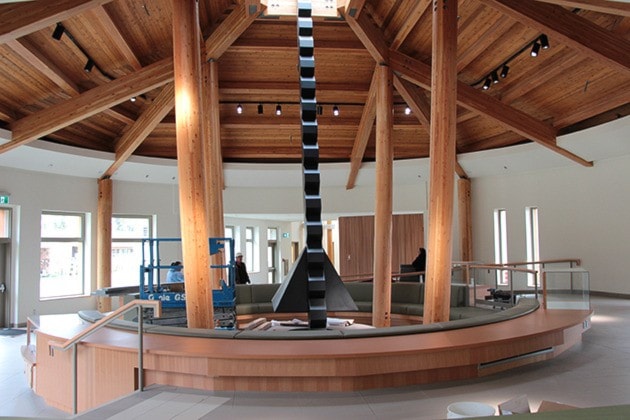Whether it’s healthcare, recreation, learning, or government, Nadleh Whut’en First Nation members of all mobility levels now have a new one-stop-shop for their service needs.
On Oct. 22, the Nadleh Whut’en Administrative and Cultural Building will be officially opening its doors to the community and its visitors.
Local, regional, and provincial dignitaries, as well as the surrounding community, are invited to join the celebration, and a time capsule to commemorate the grand opening will be buried as well, to be unearthed in 20 years.
Construction of the $19.3-million complex broke ground in June 2014, involving 2,500 square metres of space that includes a health clinic, council chambers, 16 administrative offices, classrooms, recreation and hall amenities, as well as a community kitchen. An outdoor terraced amphitheatre with a fire pit provide additional education and assembly spaces.
Designed by Evans and Wai Architects in Joint Venture with input from the Nadleh Whut’en council, the building features a pithouse-like design for council chambers and lobby, referencing the First Nation community’s ancestral way of living. Historical artefacts documenting the traditional way of living would be displayed in the lobby, and a stream of pebbled floor flowing throughout the building signifies the importance of the river to the community. The complex also incorporates green building principles such as south-facing skylights, with a over-100-year facility lifespan.
The facility will be the new home of Nadleh Whut’en’s council and administration, health unit, learning centre, and community events. Future uses of the various vacated buildings, including the original community hall that opened in July 1981, are still under discussion, said Councillor Eleanor Nooski.
Cultural artifact on loan to UNBC returns home
A culturally modified tree found in Nadleh Whut’en traditional territory, loaned by the community to the University of Northern British Columbia since 2000, will be returned to the community for display in the new building’s pithouse-like lobby.
Originally located at a Cheslatta Trail junction where a winter sleigh trail branched off on the south side of Klez Lake, six-kilometres south of Fraser Lake, the tree has a message written in pencil on cambium-stripping scar that dates to the 1870s, according to a UNBC news release.
“There is a body, Pierre, Hello, I am saying this, Antoine,” says the message in the Carrier syllabic language, as deciphered by linguist Bill Poser and three local elders — Nick Prince of Nak’azdli, Peter George of Nadleh, Edward Kelto of Saik’uz. It is unclear whether the message refers to a human body or the body of an animal that had been shot.
The tree had been killed by mountain pine beetles in 1993 and was discovered by a First Nations forestry crew member mapping the beetle-killed area. Examined by local community members and the Ministry of Forests, the tree was recorded as an archaeological site in 1995 by Arne Carlson of Traces Archaeological Research and Consulting.
During the restoration of the Cheslatta Trail in 1999 by the Nadleh Whut’en and Cheslatta Nations, crews discovered that the tree had been blown down and they transported the marked section of the tree to Nadleh Whut’en where it was temporarily stored.
